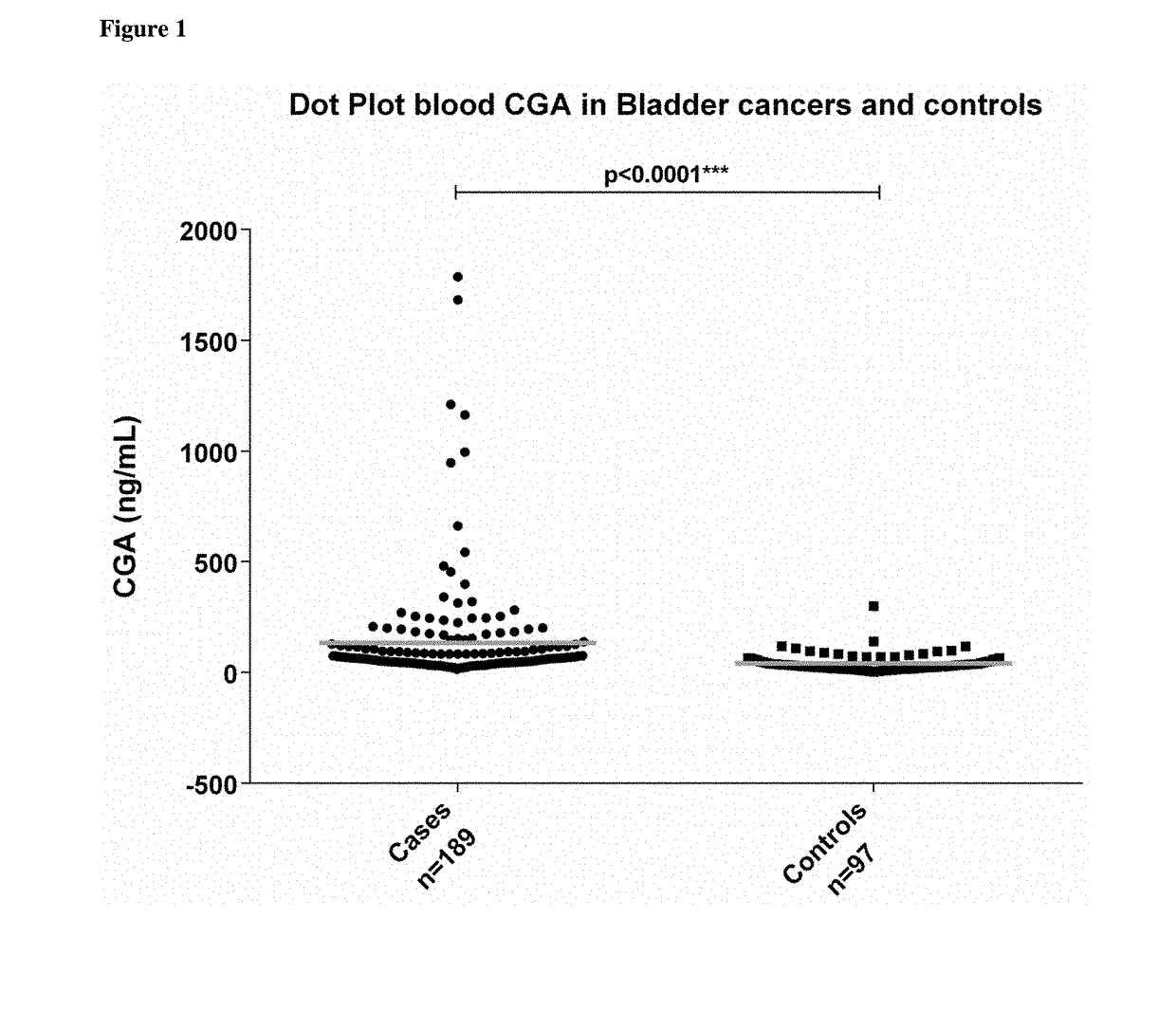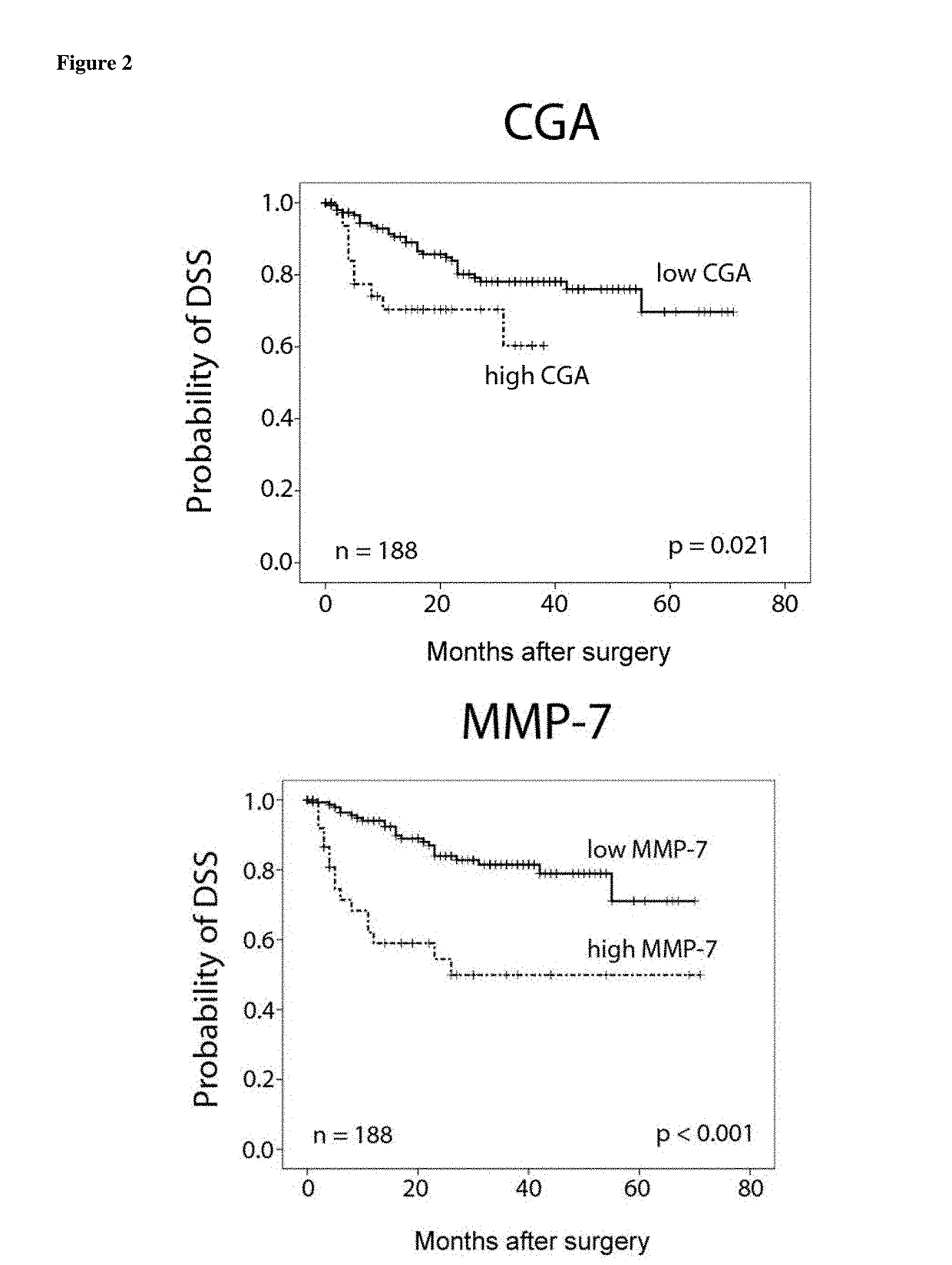Chromogranin a as a marker for bladder cancer
- Summary
- Abstract
- Description
- Claims
- Application Information
AI Technical Summary
Benefits of technology
Problems solved by technology
Method used
Image
Examples
example 1
of Chromogranin a and MMPI in Bladder Cancer Patients
Study Design
[0191]Serum samples were collected in 188 patients who underwent surgical treatment of urinary bladder cancer (BCa): transurethral resection of the bladder (TURB) or radical cystectomy (RCE). Patients were enrolled in the Department of Urology of the University Hospital Duisburg-Essen between August 2008 and November 2011. The criteria for study enrolment were histopathological diagnosis of transitional cell carcinoma of the bladder, no history of other tumor, no chemotherapy before surgery, availability of sufficient serum sample and the potential to follow up. No neuroendocrine bladder cancer was diagnosed in the population. Histological grade and T-stage were classified according to the WHO 1973 and 2004 and the 2009 TNM classification, respectively. Serum samples of 97 healthy individuals with no history of cancer were used as controls.
[0192]The study was performed in accordance with the ethical standards of the He...
example 2
ive Prognostic Value of CgA in Population Treated with Surgery (Study of Example 1)
Comparison of CgA Serum Levels Between Tumor and Control Samples
[0201]CgA concentrations were significantly elevated in serum samples of tumor patients compared to controls (median 3.9 ng / mL vs 29.4 ng / mL respectively, P<0.0001, FIG. 1).
CgA Concentration and Clinicopathological Parameters
[0202]In tumor patients, CgA concentrations were significantly higher in older patients and in male (p=0.026 and p=0.009 respectively, Table 2) CgA concentrations were correlated to stages and grades but not metastasis (Table 2).
Prognostic Value of CgA Levels in Population Treated with Surgery
[0203]Univariate Analysis:
[0204]Results of univariate analysis are listed in Table 3 and FIG. 2. Patients' age did not influence overall- or disease-specific survival in contrast to gender that has an impact on disease-specific survival (HR=0.447, CI 0.247-0.918, p=0.027). Tumor stage, grade and metastasis are significant predict...
example 3
ive Prognostic Value of CgA / MMP7 in RCE Treated Population (Study of Example 1)
[0220]The risk stratification of patients treated by radical cystectomy is of particular interest. Therefore, we also analyzed the prognostic significance of CgA levels focusing solely on this group.
Prognostic Value of CgA Levels in Patients Treated with RCE
[0221]High CgA serum concentration was a strong independent predictor of overall and disease-specific survival (HR=2.405, 95 CI 1.000-5.784, p=0.050 and HR=4.003, 95% CI 1.491-10.748, p=0.006 respectively, Table 7). High CgA concentration was significantly associated with poor disease-specific survival in patients treated by radical cystectomy (p=0.008, FIG. 3).
[0222]Twenty-month-survival rate after radical cystectomy was 76% in patients who demonstrated low preoperative concentration of CgA compared to 33% in patients who demonstrated high preoperative concentration.
[0223]Patients with high preoperative CgA concentration are at high risk of bladder ca...
PUM
 Login to View More
Login to View More Abstract
Description
Claims
Application Information
 Login to View More
Login to View More - R&D Engineer
- R&D Manager
- IP Professional
- Industry Leading Data Capabilities
- Powerful AI technology
- Patent DNA Extraction
Browse by: Latest US Patents, China's latest patents, Technical Efficacy Thesaurus, Application Domain, Technology Topic, Popular Technical Reports.
© 2024 PatSnap. All rights reserved.Legal|Privacy policy|Modern Slavery Act Transparency Statement|Sitemap|About US| Contact US: help@patsnap.com










